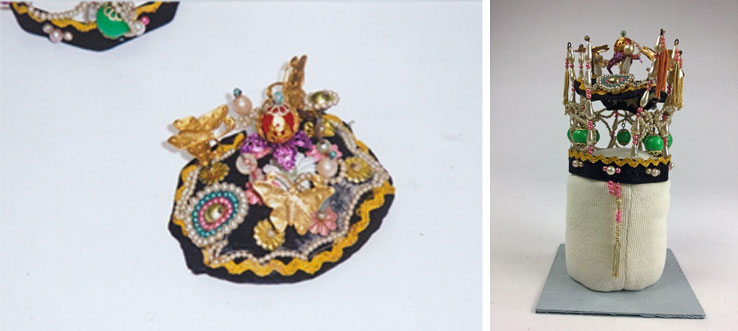Empress For A Day: Korean Bridal Crown
This is a continuation of my previous blog: describing conservation treatments for the BSM exhibition The Perfect Pair. The exhibition design featured a ceiling height multi-tiered wedding cake in the centre of the gallery and each tier functioned as display cases containing white wedding shoes. Around the perimeter of the room were large showcases designed to look like a ‘wedge’ of cake. Inside each of these wedges were brides and grooms, representing international wedding traditions, dressed in their special occasion clothes, including the footwear that would have been worn at such an event.
The exhibition, along with the floor plan above, was designed by a Montreal-based company Toboggan Design Inc. This company has designed many exhibitions for the BSM.
The BSM collects elements of clothing and accessories that help contextualize the footwear on display. In this case it was a crown for a Korean bride, purchased by the museum in 2002 and included in the exhibition. The crown is composed of two pieces: a 'brim' and a ‘cap’. Both sections are covered in black cotton velvet and highly decorated with beads in a variety of colours, shapes and sizes, including little painted metal butterflies on springs.
The picture on the left shows one of the bent beaded butterflies, in a small pouch are beads and a tassel. The picture on the right shows one of the upright beads with its tassel missing.The velvet was extremely dirty; the embellishments were dusty and some of the beads, tassels and vertical wires had fallen off. A couple of the wires and springs were not in alignment with their original placement. The two pieces of the crown were cleaned independently to facilitate accessing all of the decorative elements.
The crown removed showing butterflies mounted on tiny springs. The photo on the right is the storage mount. The tassel that hangs down made up the contents in the little plastic bag in the previous photo.Dust was removed with a low suction micro vacuum with the working end of the tool covered with a fine mesh to prevent any of the beads and butterflies from being sucked into the machine. Next, the velvet was cleaned with lightly dampened swabs. This step released the dirt, resulting in the velvet becoming fluffier. All the beads are plastic, so to prevent damage from cleaning solutions that one would use on glass beads, their surfaces were gently cleaned with micro fibre cloths. All the loose beads were sewn back in place; misshapen springs and wires were gently returned to their original positions. The final step was to sew the loose beaded tassel to the centre of the brim as it was intended to hang down the forehead of the bride.
The outfits for the bride and groom were generously loaned to the exhibition by the Historic Costume Museum, University of Hawaii. Each couple stood back to back, accompanied by footwear that would have been worn on such a significant occasion. As the bride walked, the free hanging beads and tassels in her crown would have swayed back and forth, the butterflies would have bounced on their springs, all accentuated by the rustling sound of the sumptuous silk robes. By happy coincidence, the butterfly motif is echoed in the red silk bridal shoes featured in the online exhibition The Perfect Pair.





0 comments